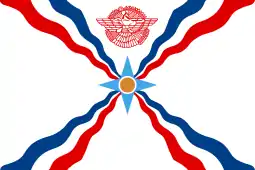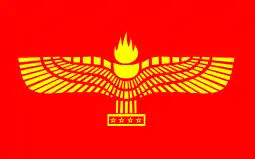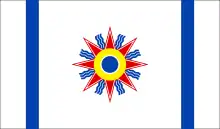Zakho
Zakho (Arabic: زاخو;[1] Kurdish: زاخۆ ,Zaxo,[2][3] Syriac: ܙܵܟ̣ܘ̇, romanized: Zākhō,[4] Hebrew: זאכו;[5] Armenian: Զախո[6]) is a city in the Kurdistan Region of Iraq, at the centre of the eponymous Zakho District of the Dohuk Governorate, located a few kilometers from the Iraq–Turkey border.
Zakho | |
|---|---|
City | |
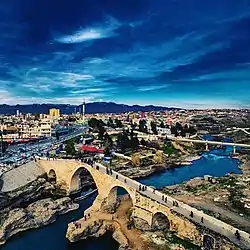 The Little Khabur flowing through Zakho | |
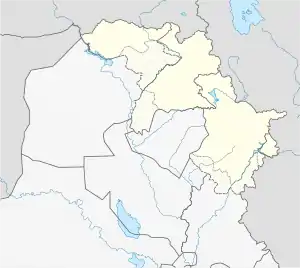 Zakho Location in Iraq  Zakho Zakho (Iraq) | |
| Coordinates: 37°08′37.00″N 42°40′54.88″E | |
| Country | |
| Region | |
| Governorate | Dohuk Governorate |
| District | Zakho District |
| Elevation | 440 m (1,440 ft) |
| Population (2010) | |
| • Total | 500,000 |
| Time zone | UTC+3 |
| • Summer (DST) | not observed |
The original settlement may have been on a small island in the Little Khabur river, which flows through the modern city. The Khabur flows west from Zakho to form the border between Iraq and Turkey, continuing into the Tigris. The most important rivers in the area are the Zeriza, Seerkotik and the aforementioned Little Khabur.[7]
Etymology
The derivation of the name "Zakho" is from the Aramaic word zāḵū (זָכוּ, "victory"), after the battle fought between the Romans and the Persians near the city, which resulted in a Roman victory.
History
Gertrude Bell, the renowned British archaeologist and Arabist who advised British governors in the region in the closing years of the British Mandate, was convinced that Zakho was the same place as the ancient town of Hasaniyeh. She also reported that one of the first Christian missionaries to the region, the Dominican mink Poldo Soldini, was buried there in 1779. The town is also the site of Zakho castle, of which today only the tower remains, and of Qubad Pasha castle, a hexagonal structure in Zakho cemetery.
According to an oral tradition transmitted by a Jewish informant from Zakho, Me'allim Levi, Zakho was established in 1568 by Slivani tribesmen, whose territory was stretched south of the location of the town. The family of Shamdin Agha came originally from the Slivani tribe, settled in Zakho, and became the most prominent family in Zakho. From the late 19th century onwards, the family of Shamdin Agha ruled “all the Muslims, Jews and Christians of Zakho and its surroundings.”[8] Zakho was known to the ancient Greeks. In 1844, the traveller William Francis Ainsworth commented: "The appearance of Zakho in the present day coincides in a remarkable manner with what it was described to be in the time of Xenophon."
Gertrude Bell was convinced that Zakho was same place as the ancient town of Hasaniyeh. She also reported that the first Christian missionary to the region, the Dominican friar Poldo Soldini, was buried there in 1779. His grave was still a pilgrimage destination in the 1950s.[9][10]
Zakho is a major marketplace with its goods and merchandise serving the Kurdish-controlled area and most of north and central Iraq. Writing in 1818, Campanile described the town as a great trading centre, famous for its gallnuts as well as rice, oil, sesame, wax, lentils and many fruits.[10]
Recent history
Due to its strategic location and the abundance of job opportunities, Zakho has attracted many workers and job seekers from different parts of Iraq and even from Syria and Turkey. Trade with Turkey is now the major element of the economy.[11] Oil drilling began in 2005.[12]
Following the rebellion of the Kurdish population in 1991, coordinated to support the Western military attacks of the first Gulf War, Saddam's reprisals were fierce and brutal, and large numbers of the townspeople were obliged to seek refuge up in the neighbouring mountains. Today's flourishing city has come a long way from the near ghost town described by American military forces arriving in 1991 as part of Operation Provide Comfort - a project to protect the Kurdish population from Saddam's reprisals. The American military presence was finally withdrawn in 1996, and the town suffered again as significant numbers of the better educated and better qualified professionals relocated to America, a brain-drain that left a shortage of skilled manpower to regenerate the city. In the event, the flourishing Kurdish economy following the last Gulf War was to provide ample impetus to compensate for this and drive the city's growth. Relations with Turkey improved sharply, and continue to strengthen, and Zakho, situated on the main trade route south, benefits from the flow of produce and construction materials that passes through its streets and onwards, not only to Kurdistan but also to the wider Iraqi region as a whole.
Both Duhok and Zakho are situated in minor tributaries of the River Tigris. Further south-east, Erbil lies on a plain in the uplands between the Great and Little Zab Rivers which also flow down to join the Tigris. Thence the waters converge and sweep down to Mosul, onwards to converge with the Euphrates by Basra and then down to join the waters of the Persian Gulf. The mighty Tigris, rising in the Tauris Mountains of south-eastern Turkey, and over one thousand miles long, is fed from the east largely from Kurdish soil until it reaches the lowlands.
The Tigris is heavily dammed in Iraq and Turkey to provide water for irrigating the arid and semi-desert regions bordering the river valleys. Historically, such damming has been seen as helpful in averting floods in Iraq, a frequent occurrence following the spring thaw and the melting of snow in the Turkish Kurdish mountains around April, but increased damming in Turkey in recent years has prompted concerns of potential droughts in future. The dam at Mosul is the largest in Iraq. The Great (or Upper) Zab river rises in the mountains south-eastern Anatolia and flows south for some 265 miles into Kurdistan before joining the Tigris south of the city of Mosul at the ancient biblical town of Calah.
Islamic history
In islamic history it is perhaps best remembered as the location of the Battle of the Zab between the Umayyads and the Abbasids.
It forms the approximate political boundary of KRG area of Iraq today. Its sister, the Little (or Lower) Zab rises in north-western part of Kurdistan province Iran, in the north of Piranshahr city and flows south-west through Iraq to join the Tigris north of the town of Baiji. The Dukan Dam straddles the Little Zab some 150 miles upstream from its confluence with the Tigris River. Constructed between 1954 and 1959, the dam has a total discharge capability of 4,300 cms. The power station, constructed in 1979, holds five water turbines and provides 400 MW of electrical energy.
In 1991, Zakho was the centre of the haven established by the British and the Americans in Operation Provide Comfort to protect the Iraqi Kurds from being massacred by Saddam Hussein when he responded brutally to the Kurdish rebellion. Most of the inhabitants of the city had fled to the mountains. When the American forces arrived, they described the town as a ghost city.[13]
The 27 February 1995 Zakho bombing killed over 50 people. When the U.S. Army closed its military base in Zakho in 1996, they evacuated several thousand Kurds who had connections to the base and who feared reprisals. Many of them were given asylum in the USA. According to David McDowall, this constituted a sudden brain drain, with Zakho losing many of its most educated citizens.[14]
In 2008 it was reported that the Turkish Army maintained four bases in Zakho District, under an agreement concluded with the Iraqi Government in the 1990s.[15]
The 2011 Dohuk riots, which targeted Assyrian-owned businesses, were sparked by Muslim clerics in the town.[16]
Demographics
Assyrians
Assyrians have lived in Zakho since at least the 5th century, with some Assyrian bishops being mentioned from the fifth to the seventh century. The city was the center of a large Chaldean Catholic diocese up until the middle of the nineteenth century, when it was divided into three dioceses: Amadia, Zakho, and Akra-Zehbar. The historic diocese of Zakho corresponded with the ancient Diocese of Malta, formerly a suffragan of Arbela, and it had many Chaldean Catholic villages and parishes in the mountains to the north of the city. [17] However, the diocese was recently merged (or in religious terminology, suppressed) back into the Chaldean Catholic Eparchy of Amadiya in 2013 due to becoming vacant after the death of its bishop in 2010. Prior to merging with Amadiya, the diocese comprised 3500 Assyrian Catholics, ten resident priests, fifteen parishes or stations, twenty churches and chapels, and one primary school. Modern Zakho has a large Assyrian population. The Assyrians of Zakho are primarily Chaldean Catholic Christians and have two churches, one of which is in the center of the city and once functioned as the Cathedral of the Diocese. As of 2020, Assyrians in Zakho are numbered at around 6,500-7,000 [18][19]
Armenians
The Armenians of Zakho established their community after the Armenian Genocide, with the first Armenian church in the city being established in 1923.[20] Some of the Armenians of Zakho left in 1932 to found the village of Avzrog Miri in the plains west of the city of Simele.[21]
Jews
Zakho was formerly known for its synagogues and large, ancient Jewish community and was known as "The Jerusalem of Kurdistan."[22] The banks of the nearby Khabur River are mentioned in the Bible as one of the places to which the Israelites were exiled (1 Chronicles, 5:26,[23] 2 Kings 17:6, 2 Kings 18:11).
The Jews spoke the Aramaic of their ancestors and were also fluent in Kurmanji, the language spoken by non-Jewish Kurds.[24]
Kurdish society was primarily a tribal one. The Jews of Zakho bore arms like Kurdish Muslims.[25] There was an attack on the Jews in 1891, when one of the synagogues was burnt down. The troubles intensified in 1892.
Most of the Jews relocated to Israel in the 1950s.[26] While the Jews of Zakho were among the least literate in the disapora, they had a unique and rich oral tradition, known for its legends, epics and ballads, whose heroes came from both Jewish and Muslim traditions.[27]
Climate
Zakho has a hot-summer Mediterranean climate (Csa in the Köppen climate classification) with very hot and dry summers, and cool winters with high rainfall.
| Climate data for Zakho | |||||||||||||
|---|---|---|---|---|---|---|---|---|---|---|---|---|---|
| Month | Jan | Feb | Mar | Apr | May | Jun | Jul | Aug | Sep | Oct | Nov | Dec | Year |
| Average high °C (°F) | 10.2 (50.4) |
12.2 (54.0) |
16.5 (61.7) |
21.8 (71.2) |
29.1 (84.4) |
36.2 (97.2) |
40.4 (104.7) |
40.0 (104.0) |
35.7 (96.3) |
27.9 (82.2) |
19.4 (66.9) |
12.3 (54.1) |
25.1 (77.3) |
| Average low °C (°F) | 1.9 (35.4) |
3.1 (37.6) |
6.1 (43.0) |
10.1 (50.2) |
15.0 (59.0) |
20.1 (68.2) |
23.7 (74.7) |
23.2 (73.8) |
19.2 (66.6) |
13.7 (56.7) |
8.4 (47.1) |
3.9 (39.0) |
12.4 (54.3) |
| Average precipitation mm (inches) | 144 (5.7) |
136 (5.4) |
129 (5.1) |
109 (4.3) |
43 (1.7) |
0 (0) |
0 (0) |
0 (0) |
1 (0.0) |
27 (1.1) |
83 (3.3) |
127 (5.0) |
799 (31.6) |
| Source: [28] | |||||||||||||
Landmarks
.JPG.webp)
One of Zakho's famous landmarks is the Delal Bridge, made of stone.
Zakho Castle lies in the city centre on the western bank of the Khabur. It served as the governor's house in the reign of the Badinan Emirate and was enlarged by Prince Ali Khan. It was built on the ruins of an older castle. Today, only the castle's tower remains.

The Qubad Pasha Castle, in Zakho's cemetery, is hexagonal, with six windows and an entrance gate.[29]
Population displacements
Many Assyrians living in the diaspora, notably in American cities Chicago, Detroit, San Diego, Houston, and Phoenix, trace their origins to Zakho.
In 2007, the UNHCR reported that there were still 10,000 internally displaced persons in the Zakho district as a result of the Iraq War.[30]
Sports
Zakho Football Club (Zakho FC) was founded in 1987. The sports club plays in the Iraqi Premier League, where only the top 16 Iraqi football clubs play. Zakho FC has its own stadium with a capacity of 20,000 seats.
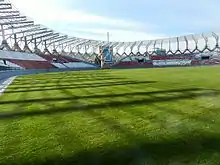
Zakho Basketball Club (Zakho SC) won the Kurdistan Basketball Super Cup and beat Duhok SC in Erbil.[31]
References
- "زاخو | كوردستان المدهشة - الموقع الرسمي للسياحة في كوردستان". bot.gov.krd (in Arabic). Retrieved 19 December 2019.
- "زاخۆ" (in Kurdish). Retrieved 18 December 2019.
- Celilê Celil, Dzhalile Dzhalil (1985). Jiyana rewşenbîrî û sîyasî ya Kurdan: di dawîya sedsala 19'a û destpêka sedsala 20'a da (in Kurdish). p. 154.
- "List of all entries". Assyrian Languages. Retrieved 10 March 2020.
- "קהילות - זאכו". www.kurdishjewry.org.il (in Hebrew). Retrieved 19 December 2019.
- "ԻՐԱՔՅԱՆ ՔՈՒՐԴԻՍՏԱՆ". Արեւմտահայաստանի եւ Արեւմտահայութեան Հարցերու Ուսումնասիրութեան Կեդրոն (in Armenian). 19 October 2010. Retrieved 19 December 2019.
- http://www.zaxo.at/index.php?page=32 Archived 2011-07-06 at the Wayback Machine retrieved the 15th of May 2011
- Mordcechai Zaken, Jewish Subjects and their Tribal Vhieftains in Kurdistan, 2007: 33-35.
- Bell, Gertrude Lothian (1924). Amurath to Amurath. Macmillan. Retrieved 2009-09-06.
- Campanile, Giuseppe (1953). "Histoire du Kurdistan" (PDF). Le Kréyé. Retrieved 2009-09-06.
- "KDP Flexes Muscles in Dohuk". Institute for War and Peace Reporting. 2009-07-21. Retrieved 2009-09-06.
- "Foreign oil deal renews debate on Kurd autonomy". USA Today. 2005-12-09. Retrieved 2009-09-06.
- Cavanaugh, John P. (1992). "Operation Provide Comfort: a model for future operations" (PDF). School of advanced military studies, Fort Leavenworth, Kansas. Retrieved 2009-09-06.
- McDowall, David (2004). A modern history of the Kurds. Tauris. ISBN 9781850434160. Retrieved 2009-09-06.
- "Iraqi Kurdish Paper Says Turkish Military Bases Inside Kurdistan Region". iStockAnalyst. 2008-08-01. Archived from the original on 2011-10-04. Retrieved 2009-09-06.
- Tawfeeq, Mohammed (3 December 2011). "Kurdish leader: Clerics 'instigated ... acts of sabotage,' wounding 25". CNN. Retrieved 4 December 2011.
- "Chaldean Parishes around the world". St Peter the Apostle Catholic Diocese for Chaldeans and Assyrians USA. Archived from the original on 2009-08-14. Retrieved 2009-09-06.
- "Maryam Alazra church – Zakho". www.ishtartv.com.
- "Maryam Alazra church – Zakho-Abbaseya". www.ishtartv.com.
- "Maryam Alazra church –Zakho – Kesta". www.ishtartv.com.
- kurdisharmenian.blogspot.com/2008/10/avzrok-armenian-village-in-southern.html
- "Unwitting Zionists | Wayne State University Press". www.wsupress.wayne.edu. Retrieved 2020-06-19.
- 1 Chronicles 5
- Gavish, Haya (2009). "Unwitting Zionists: The Jewish Community of Zakho in Iraqi Kurdistan p.48". Wayne State University Press. Retrieved 2009-09-06.
- Gavish, Haya (2009). "Unwitting Zionists: The Jewish Community of Zakho in Iraqi Kurdistan p.28". Wayne State University Press. Retrieved 2009-09-06.
- Gavish, Haya (2009). "Unwitting Zionists: The Jewish Community of Zakho in Iraqi Kurdistan". Wayne State University Press. Retrieved 2009-09-06.
- Shai, Donna (2008-10-09). "Changes in the oral tradition among the jews of kurdistan". Contemporary Jewry. Contemporary Jewry - Springer Netherlands. 5: 2–10. doi:10.1007/BF02965657. S2CID 143952535. Retrieved 2009-09-06.
- "CLIMATE: ZAKHO". Climate-Data. Retrieved 21 January 2017.
- "Zaxo". Kurdawary. 2004. Archived from the original on October 25, 2009. Retrieved 2009-09-06.
- "GOVERNORATE ASSESSMENT REPORT: DAHUK GOVERNORATE" (PDF). UNHCR. September 2007. Retrieved 2009-09-06.
- "Zakho wins Kurdistan basketball Super Cup Archived 2014-03-07 at the Wayback Machine," Kurdish Globe, retrieved 2014-01-30
Sources
- Chabot, Jean-Baptiste (1902). Synodicon orientale ou recueil de synodes nestoriens (PDF). Paris: Imprimerie Nationale.
External links
| Wikimedia Commons has media related to Zakho. |
